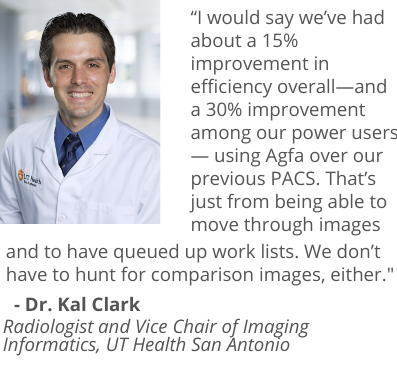Last year the institutional leadership at Texas’s University Health System, which contracts with the UT Health San Antonio physician network, made the decision to move all inpatient imaging off the radiology department’s PACS and onto a new enterprise imaging (EI) platform. Their goal was internal consolidation. The team had watched their sprawling health system bend under the weight of unintegrated imaging-management solutions from numerous vendors. Now they saw plenty of room for improvement in operational efficiencies as well as economies of scale.
The leaders’ case for making the move was airtight: Imaging consolidation would represent a sizeable step toward getting the entire health system to work like a unified enterprise instead of a patchwork of siloed groupings.
In addition to communicating this decision, the leadership group indicated its strong and unanimous preference for a particular vendor’s particular platform—Agfa HealthCare’s Enterprise Imaging for Radiology. The team based its choice on University Health System’s healthy existing relationship with Agfa HealthCare.
Given the two-part essence of the directive, reactions among the 60 or so members of the radiology department were unsurprisingly mixed.
For starters, receiving the technology solution as part of a strong institution-wide imaging preference “was a reminder imaging goes beyond the radiology department,” recalls Kal Clark, MD, a staff emergency radiologist who was serving as director of imaging informatics at the time. “That made it easier for radiology and tougher too. Nobody wants to be the one department hitting the brakes while every other department is all in. But the EI acquisition and adoption process is more akin to buying an EHR than to buying a PACS.”
Enterprise EHR Additive
Clark soon came to appreciate the several subsequent meetings Agfa HealthCare conducted to detail Enterprise Imaging for Radiology’s fundamentals, features and fine points. He also liked that hospital leadership was enthusiastically open to letting the radiology department consult other Agfa hospital customers using the solution around the country.
Further, Agfa EI for Radiology would enter as a “candidate replacement” for inpatient imaging, which accounts for around 80% of the institution’s imaging business. Another supplier’s PACS would continue serving the outpatient side of the house. The qualified jump-off would allow for head-to-head comparisons going forward.
Nearly a year has passed since the go-live in December 2019. In the time since, Clark, who was recently promoted to vice chair of imaging informatics, seems to have been won over.
“We did our best to evaluate and ask around, but a change like this still ends up being a leap of faith,” says Clark, who has, through the EI adoption process, grown into his unofficial role as lead physician champion of enterprise imaging. “Today we’re in this great position where we’ve got the Epic EHR, which we just installed this summer, and where we’ve already got enterprise imaging to complement it.”
Digitized Control
Agfa HealthCare’s Enterprise Imaging for Radiology is a standalone imaging platform designed to centralize patient information coming in from disparate clinical departments. The system consolidates and unites PACS, radiology reporting, advanced image processing, integration of clinical information, results distribution and analytics. In so doing, it equips healthcare workers, as Agfa notes, “to quickly access the patient’s complete file, generate a report and distribute it, all during one session—even from a remote location.”
Clark was generous with Health Imaging in describing how those product claims have played out at UT Health San Antonio.
Asked how smooth—or rough—the transition was following the go-live, Clark points out that the department’s radiologists run the gamut on “tech receptiveness” from technophobes to technophiles.
As the EI physician champion, he first worked with Agfa support people and UT radiology power users to familiarize the rest of the department with the Agfa EI system on the fundamentals of the front end—mouse clicks, keyboard shortcuts and the like.
“The learning curve was steepest when it came to teaching some of the work lists,” Clark reports, adding that the payoff was worth the trouble. “Agfa’s work list functionality is advanced. Agfa EI gives you a lot more control over your lists, a lot more ability to modify and change acuity levels, flag studies, change the color of certain studies to signal levels of urgency, all of that. And that digitized control replaces what in the past would have taken time-consuming phone calls.”
Unimpeded ‘Radiologist Velocity’
Meanwhile Clark took it as a good sign when the go-live proceeded without a hitch and with no significant downtimes.
“One of our big achievements, and Agfa’s big achievements, is having a really strong showing of uptime,” he says. “Our rate of crash events is very low. We were struggling somewhat with that before bringing in Agfa. But we’ve had great success minimizing crash events since implementing Agfa EI for Radiology.”
Clark pauses on that point before adding that the product shows its technical and engineering prowess on three fronts: stability, visual appeal and efficiency. He says the department has seen some major gains when working with images that are either postsurgical, involve a change in patient positioning or rely on 3D registration for determining if a lesion is smaller, the same or bigger compared with a prior study.
“One imaging study that always drops our radiologist wRVU velocity through the floor is the post-op head CT craniotomy,” he says, underscoring his preference for wRVU velocity over turnaround times as the more meaningful performance metric. “The capability of Agfa EI to let us do a 3D registration showing both the presurgical and post-op images—on the exact same plane and at 1:1 scale, side by side—is a huge help.”
He notes the easy-to-use tool’s particular utility in the ED, where many patients are too sick to hold still for their CT scan.
“Before Agfa, we were kind of figuring out 3D registration on our own,” Clark says. “Now we’re doing it with technology that’s both easy to use and precise.”
Championed to Victory
Clark reports similarly high satisfaction with numerous other aspects that he says Agfa EI for Radiology has been delivering these past eight months.
“Before we implemented Agfa EI for Radiology, we had to manually type in every accession number in order to bring a study into the PACS and our EHR,” he says. “The ability we now have to just click on a study in Agfa and have it launch in Epic and PowerScribe is a huge gain. That immediately saved us five seconds per study.”
He says the radiologists of UT Health San Antonio are equally happy with improvements they’ve seen related to hanging protocols and findings comparisons, apart from the ED head CTs already mentioned.
“This is where Agfa was smart to run training and the EI implementation through a physician champion instead of the traditional model using a group of trainers,” he says. “Agfa approached me with all the cool stuff the product can do, and asked how I thought they could improve it, every week for a couple of months.”
The results, he suggests, have been game changing.
 Better Comparisons and Protocols
Better Comparisons and Protocols
For example, prior to implementing Agfa EI for radiology, comparison imaging often wouldn’t show up in a format that was workable for side-by-side comparisons, Clark says.
“With Agfa EI for Radiology we’re able to consistently display all the relevant imaging comparisons,” he says. “I would say we’ve had about a 15% improvement in efficiency overall—and a 30% improvement among our power users—using Agfa over our previous PACS. That’s just from being able to move through images and to have queued up work lists. We don’t have to hunt for comparison images, either."
At the same time, hanging protocols have become a snap.
“Whereas before we had to manually load or pre-load a lot of images, not to mention deal with totally broken hanging protocols, now our hanging protocols are much more efficient,” Clark says.
Bringing this to the full spectrum of radiologists is a work in progress, he notes, because of the aforementioned comfortability continuum.
“The radiologists who’ve been able to make their own hanging protocols and understand how they work are already optimized on that part,” Clark says. “They like Agfa and have become Agfa’s biggest cheerleaders here. The radiologists who are still sitting on the fence will probably do the same as soon as the customized hanging protocol rollout to non-power users is complete.”
Appreciated Value-Adds
Clark talks at some length about other noteworthy returns University Health System is realizing from its investment in Agfa EI for Radiology. These include:
Customization. “Working with Agfa to tailor the EI system for our needs has been key. Everything in the process was transparent, and I was involved in developing the rules for how things are displayed. We’re now at the point where the amount of extra clicks—and any extra brainpower we have to devote to just getting things working correctly—is fairly minimal. And that goes for stuff that happens just about anywhere inside the enterprise.”
Time savings. “As an overnight ED radiologist, I have a very well-defined reading workload. I have no meetings, no lectures during those hours, so I have a very good sense of how long it takes me to do my job between Agfa and our outpatient PACS. The difference is significant. We’re talking 30 minutes to an hour of additional time given back to me per day.”
Collaboration and sharing. “Agfa EI for Radiology has a tool for sharing screens between two different users. It lets me, for example, move the mouse on a clinical colleague’s screen so I can explain, via chat, various things I see in the findings. That function has been particularly useful during the COVID crisis, when we’ve had dividers separating radiologists to keep germs from spreading in the reading room. The Agfa collaboration tool lets us keep up with resident training, and it allows us to put our heads together on patient care even in this weird pandemic environment.”
Looking ahead, Clark has ideas on where UT Health San Antonio might advance on the strength of enterprise imaging in the coming months and years.
‘Getting the Job Done for Patients’
“Referring clinicians can now see annotated images and radiology reports through a thin client running in the EHR,” he says. “The referrer can see all things imaging on any hospital computer and then go into the patient’s room with a full understanding of radiology findings.”
Stated another way, Agfa Enterprise Imaging for Radiology is meeting the need UT Health San Antonio has for point-of-care information exchange. And this points to all sorts of possibilities going forward.
“The next level is giving certain referrers, such as orthopedic surgeons, an integrated experience,” Clark says. “They’ll be able to go into the OR and view images right there for treatment planning or for whatever else they could use during surgery.”
Clark’s clear approval of Agfa EI for Radiology begs the question: How rewarding has the successful adoption been for the C-suite at University Health System? After all, they’re the ones who took the risk by making an enterprise-wide shift.
Mutiny was never likely, but things could have gone south in other ways.
“I think from hospital leadership’s point of view the salient question is whether or not the hospital is running as safely and efficiently as it can,” Clark says. “Are we getting the job done for patients? And we definitely are.”

